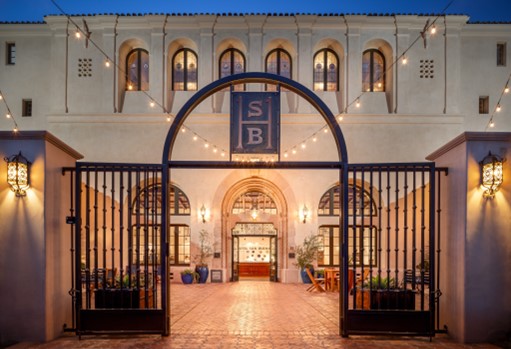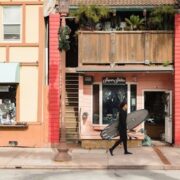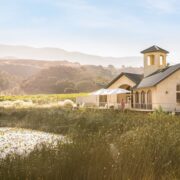
Photo credit: Ben Ingram for Visit Santa Cruz
Tales from the Pacific Coast Highway
Discover the stories that shaped the Central Coast on a journey through time and place.
Embark on a captivating 7-day road trip through California’s Central Coast, where every stop unveils a different chapter in the region’s rich and diverse history. Discover the legacy of world-renowned surfing pioneers, literary luminaries and Native Californian heritage, while also exploring iconic film locations and tracing the path of California’s Mission Trail. Beginning in Simi Valley and Ventura, the journey takes you through the scenic landscapes of Santa Barbara County and SLO CAL, winds through the fertile agricultural heartlands of the Salinas Valley and San Benito County, and concludes in the laid-back seaside charm of Santa Cruz.
Photo credit: Courtesy of Hotel San Buena
Day 1: Simi Valley to Ventura
Start your adventure stepping back in time at Corriganville Movie Ranch in Simi Valley. More than 3,500 movies, TV programs and commercials were filmed on location in the rural setting starting in the 1940s. (You might recognize it from Quentin Tarantino’s “Once Upon a Time in Hollywood” released in 2019.) Today, it’s a public park with five trails, allowing you to dust up your boots following in the footsteps of stars like Gene Autry, Roy Rogers and John Wayne.
Head to Ventura, a deeply rooted surf town where cowboys and waves converge. Surfers started traveling up the coast from Los Angeles in search of good waves back in the 1930s and it’s been on the map ever since. In 1981, local surf legend Steve Walden released his Magic Model, a blueprint that earned him the nickname of “Father of the Modern Longboard.” You can rent boards and shop for gear at his surf shop, Walden Surfboards. Pro surfer Dane Reynolds’ Chapter 11 TV Surf Shop is also well worth checking out for original apparel.
In the downtown Main Street district, soak up the peaceful atmosphere of Mission San Buenaventura and check out the latest history, art and cultural exhibitions on show at the Museum of Ventura County. For a hotel with a backstory of its own, check into Hotel San Buena, a boutique hotel in a former Elk’s Lodge and historic building originally constructed in 1927.
Pick a spot in Ventura’s Taco District for a dinner of authentic Mexican fare along what locals call “The Avenue.” While in the neighborhood, stop at Municipal Winemakers for a glass of local wine in a laid back setting.
Driving Time: 1.25 hours
Overnight: Ventura
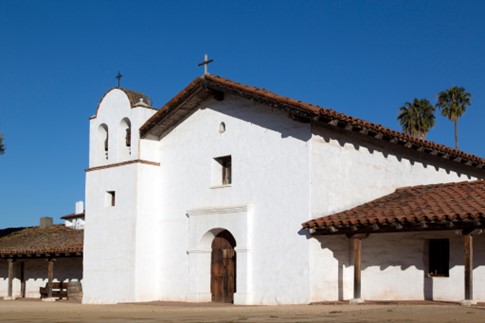
Photo credit: El Presidio de Santa Barbara by Carol Highsmith via Visit California
Day 2: Ventura to Santa Barbara
Start the day with a morning walk around Ventura Harbor Village and Surfer’s Knoll beach. Pack up and hit the highway north to Santa Barbara. En route, you’ll drive past legendary Rincon Beach, a renowned surf break known as “Queen of the Coast” for its near-perfect rights. Stop for lunch in Summerland or Montecito and browse the shops in either enclave, both located right off of US-101.
Explore Santa Barbara’s self-guided Red Tile Walking Tour, encompassing architectural gems and historic landmarks in the heart of downtown–stops include El Presidio de Santa Barbara State Historic Park, the site of the city’s founding under Spanish rule in 1782. See a less traditional side of Santa Barbara in the eclectic, colorful Funk Zone, a hub of wine tasting rooms, craft breweries, art galleries, eateries and murals. Drop into one of its longtime retail establishments, legendary surfboard shaper Al Merrick’s Channel Islands Surfboards flagship, where you can buy exclusive Santa Barbara apparel.
Before the day winds down, go to the harbor to check out the Santa Barbara Maritime Museum’s surf history exhibit and pop upstairs to the Outdoors Santa Barbara Visitor Center to take in the elevated view. Savor the sunset and dinner of local catch at always-buzzy Brophy Bros.
Driving Time: 30-45 minutes
Overnight: Santa Barbara
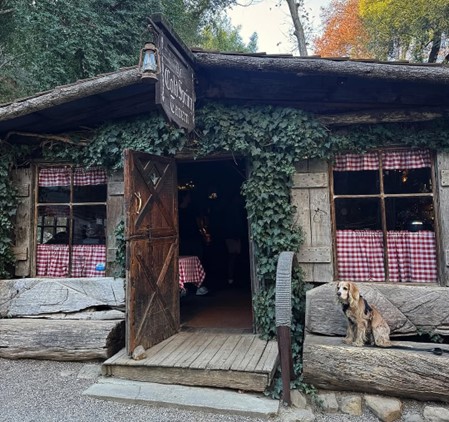
Photo credit: Cold Spring Tavern by @thebetslife
Day 3: Santa Barbara to Santa Ynez Valley
Have a breakfast picnic on the lawn of the A.C. Postel Memorial Rose Garden and then stroll around picturesque, historic Old Mission Santa Barbara, the 10th of California’s 21 missions and only to be continuously occupied by the Franciscans. Wander the trails, take in the views and learn about native plants at nearby Santa Barbara Botanic Garden.
Drive over the San Marcos Pass towards the Santa Ynez Valley, stopping at Cold Spring Tavern for lunch. The former stagecoach stop circa 1868 exudes western ambience and is known for its barbecue. Learn more about the stagecoach era upon arrival in the township of Santa Ynez, home to the Santa Ynez Valley Historical Museum, which boasts one of the largest carriage collections in the west. Stroll around the small western town, filled with independent shops, restaurants and wine tasting rooms. (Note: the brand new Santa Ynez Chumash Museum and Cultural Center is slated to open by summer 2025 and will become a must-see.)
Continue on to Mission Santa Ines, occupying a scenic perch on the outskirts of Solvang. The 19th California mission founded in 1804, it was the first European settlement in the Santa Ynez Valley. In Solvang, check out the California Nature Art Museum, browse for books at The Book Loft and peruse the free Hans Christian Andersen Museum upstairs–a tribute to the Danish fairytale writer and nod to the town’s Danish heritage.
Have dinner in Solvang at Peasant’s Feast or Coast Range, or pop over to nearby Buellton to dine at Hitching Post II, a Santa Maria-style steakhouse that played a starring role in the 2004 film “Sideways.”
Driving Time: 1 hour
Overnight: Solvang
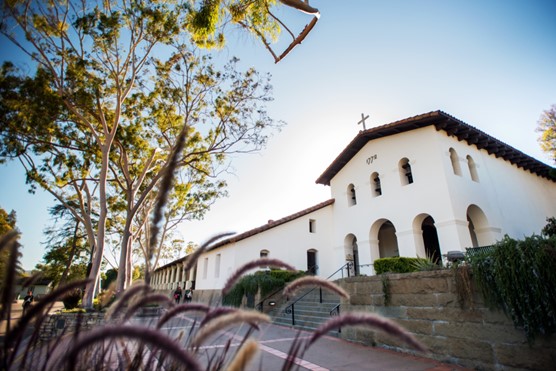
Photo credit: Mission San Luis Obispo de Tolosa courtesy of Visit San Luis Obispo
Day 4: Santa Ynez Valley to San Luis Obispo
Enjoy breakfast at one of the traditional Danish restaurants and bakeries in Solvang and then hop in the car to head west to Lompoc for a walk around La Purisima Mission State Historic Park. California’s most fully restored mission, the site features adobe buildings, a water system, agricultural fields, livestock and miles of walking trails.
Travel Highway One north to the small coastal town of Guadalupe. En route you’ll pass Vandenberg Space Force Base, the west coast site of satellite and rocket launches for the Air Force, NASA and other entities (visitors are not allowed but you’ll be in the zone!). Stop at the Guadalupe-Nipomo Dunes Center to learn about the natural habitat and the film history; the sets of Cecil B. DeMille’s epic 1923 silent film “The Ten Commandments” were buried in the sand after production and the museum houses artifacts that have been unearthed.
After a walk along the beach, continue north to downtown San Luis Obispo. If you appreciate some good, over-the-top kitsch, stop by the colorful Madonna Inn. An iconic Highway One road stop since opening in 1958, it’s what Instagram dreams are made of. Get settled at your hotel and then walk around downtown SLO, browsing the local shops, including Moondoggies Beach Club surf shop and Buen Dia, a local printmakers collective–both offer truly local souvenirs. Check out Mission San Luis Obispo de Tolosa in the heart of downtown along San Luis Creek, the original water source for the mission and the city. Enjoy dinner in a storied venue such as Mee Heng Low Noodle House, an original Chinatown landmark dating back to 1927, or Granada Hotel & Bistro, set in a 1922 era building.
Driving Time: 1.5 hours
Overnight: San Luis Obispo
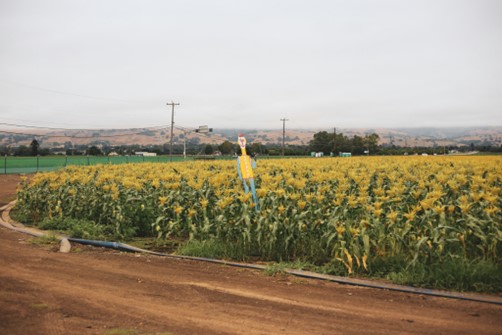
Photo credit: Salinas by Dyana Wing So via UnSplash
Day 5: San Luis Obispo to Salinas
Spend a leisurely morning in leafy San Luis Obispo before hitting the road north on US-101. Stop in Atascadero to check out the evolving ag town, which has attracted a new generation of entrepreneurs and artisans. Explore the charming downtown district and tour the Historic City Hall and Historical Society Museum to learn more about the city’s roots.
Back on the highway, stretch your legs on mission hopping stops at Mission San Miguel Arcángele (1797) and Soledad Mission (1791) en route to Salinas, the southern gateway to Monterey County. While in Soledad, pay a visit to Pinnacles National Park, where an ancient volcanic eruption created the dramatic, otherworldly landscape.
Upon arrival in Salinas, make the California Welcome Center – Salinas in the historic Southern Pacific Freight Depot your first stop. Also the Salinas Regional Heritage Center, the venue features historic exhibits covering everything from John Steinbeck and agriculture to transportation–and you can get all the travel tips you need from knowledgeable locals.
Check into your hotel and have dinner in Oldtown Salinas. Sip local craft brews paired with quality pub fare at Alvarado on Main set in an Art Deco 1929 building. Or, if you’re more curious about regional wines, go to Amapola Kitchen & Wine, equally known for its menu fueled by locally-grown ingredients.
Driving Time: 2+ hours
Overnight: Salinas
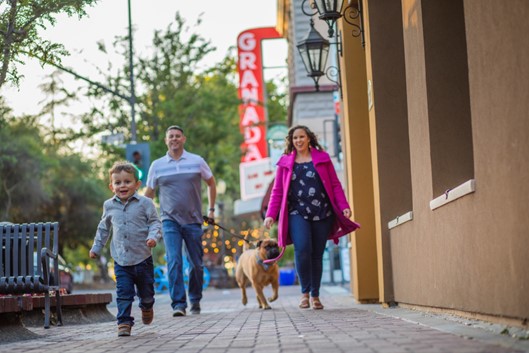
Photo credit: Downtown Morgan Hill courtesy of Visit Morgan Hill
Day 6: Salinas to Morgan Hill
Delve into the world of Nobel and Pulitzer Prize winning writer John Steinbeck, a native son of the Salinas Valley who set many of his famed novels (including East of Eden and Of Mice and Men) in the region. Visit the National Steinbeck Center to learn more about his life and literary career and have lunch inside his childhood home at The Steinbeck House, a restored Queen Anne Victorian that now operates as a restaurant and gift shop.
Head northeast on CA-156 East to the quaint hamlet of San Juan Bautista, a well preserved village with a mix of original Spanish and western buildings in its nationally registered historic district. Tour Mission San Juan Bautista (1791) and San Juan Bautista State Historic Park and browse the shops before getting back onto the highway. Take a slight detour to Casa de Fruta in Hollister. The family farming operation started in 1908 and expanded over the decades from a cherry stand into a full fledged attraction with a restaurant (1967), winery, brewery, amusement rides, hotel and marketplace selling all the food products the Zanger family grows and produces.
Stocked up on local bounty, head west on CA-152 to Gilroy, the garlic capital of the world, where 50% of the U.S. garlic supply is grown and 90% of it gets processed. Begin at the Gilroy Museum to learn about the city’s early settlers and agricultural roots and then take a stroll through Downtown Gilroy, where historic buildings and quiet streets capture the charm of a bygone era. Just outside the city, explore Chitactac-Adams Heritage County Park, a sacred Native American site with a peaceful trail and interpretive displays that offer insight into the lives and traditions of the Amah Mutsun people who once lived there.
Your final destination of the day is Morgan Hill, one of Silicon Valley’s southernmost communities. Tour the Native American Garden at Villa Mira Monte to see what plants the Amah Mutsun used for food, medicine and weaving. Set in a 1911 farmhouse on the same property, Morgan Hill Museum showcases exhibits, artifacts and memorabilia that highlight the region’s history. After refreshing at your hotel, spend the evening in the charming walkable downtown historic district with plentiful dining options.
Driving Time: 1.75 hours
Overnight: Morgan Hill

Photo credit: Steamer Lane by Ben Ingram
Day 7: Morgan Hill to Santa Cruz
Sample more of the region’s agricultural abundance over breakfast at MOHI Farm and then hit the road for Santa Cruz. Drive CA-17 South from CA-85 North for the scenic mountain route that carves through redwood forests. Stop at The Mystery Spot for gravity-defying photo ops at the quirky roadside attraction that opened in 1939.
Once in town, visit Santa Cruz Mission State Historic Park, where the state’s 12th mission was founded in 1791, and exhibits tell the story of the mission through the lens of the native Ohlone and Yokuts people. Then head to the shore to get acquainted with local surf culture and history at the Santa Cruz Surfing Museum, set inside a historic lighthouse. Hailed as the birthplace of mainland U.S. surfing and a longstanding center of California’s skateboarding scene, Santa Cruz County’s influence on surf and skate culture has been monumental–including the contributions of late local, Jack O’Neill, who is credited with inventing the game-changing wetsuit.
After your surf history lesson, watch surfers riding the waves at Steamer Lane along West Cliff Drive. Cruise down to Jack O’Neill Restaurant & Lounge in the Dream Inn for a meal of Jack’s favorites overlooking the beach, followed by some chill time on the sand. End the day at the Santa Cruz Beach Boardwalk, a key location in the 1987 film “The Lost Boys.” Ride the 1911-era Loof Carousel, which featured prominently in the film, and don’t miss the thrills of the equally historic and iconic Giant Dipper wooden roller coaster.
Driving Time: 1.25 hours
Overnight: Santa Cruz
By Shannon Brooks
